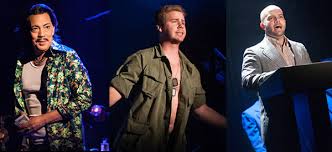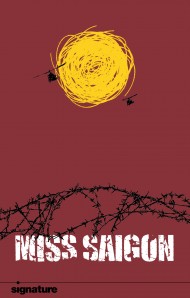Here is my (very belated) post about Signature’s production of Miss Saigon.
**Disclaimer: I do work at Signature Theatre, so my opinion is probably biased. But I was genuinely, pleasantly surprised by the production, so I thought it was worth recording here.**
When I first heard that Signature was doing Miss Saigon, I’ll admit that I was skeptical. Dramaturgically, this show has some issues. The original story about a helpless Asian geisha who tragically falls in love with a Westerner first appeared in print in 1898 by American writer John Luther Long. Giacomo Puccini seized upon the story and turned it into the still-widely-performed opera Madama Butterfly. Inspired by this story and the famous photo of “The Fall of Saigon” by Hubert van Es, Les Miserables creators Alain Boubil and Claude-Michel Schonberg saw another opportunity to stage a tragic love story. However, two French guys making a musical about the American war experience in Vietnam (AND the Vietnamese women’s experience with American G.I.’s!) resulted in moments of racism and sexism that pervade the show. Furthermore, the 1989 Broadway performance is most remembered for a ridiculous feat of spectacle that involved landing an actual helicopter on the stage. While that is technically impressive, little was said about whether the other 130 minutes of the show had any substance.
As a dramaturg viewing this performance, I wondered how do you perform Miss Saigon in a post-orientalism, post-third-wave-feminism world? I love Les Mis, I love musicals, and I love my new theatre. But could I condone a show that has traditionally encouraged stereotypes that reflect badly on Asian people and women?
Signature’s production proposed an answer. With smart staging, bold design, and actors willing to hold nothing back to give their characters dimension, Miss Saigon could be both historically sensitive and emotionally riveting.
Visually, the sprawling jungle of a set design (made of actual Vietnam planes!) by Adam Koch caused the audience to be immersed in the world and engage in the show almost as active accomplices rather than passive observers, especially in Signature’s small, 275-seat theatre. Chris Lee’s emotive lighting, varying from soft candlelight to garish neon, added beautifully to creating striking pictures onstage. One of my favorite visual moments was “The Morning of the Dragon.” I’ve always thought those lyrics don’t really make any sense, but thanks to the design and choreography team, I knew exactly what was happening in the world of the show. Abrasive red lighting, viciously restrained martial arts choreography by Karma Camp, and identical masks from costume designer Frank Labovitz that concealed all but a chorus of glaring eyes, spoke of a chilling dictatorship more powerfully than any lyrics could.

“The Morning of the Dragon”
I kept waiting for the Firebending to begin!
- As the actors breathed life into the show, they began to win me over as well. I enjoyed watching Gannon O’Brian grow into his role as American G.I. Chris over the course of the show, particularly knowing that he had been called to rise from the understudy of Chris to the lead role only days before opening night. Thom Sesma seemed completely at home reprising his role from the Broadway National Tour as the sleazy Engineer, and he had me laughing at, and almost even liking, the self-serving scoundrel. Chris Sizemore became one of my personal favorites for giving Chris’ best friend John one of the most believable character arcs of the show. In the first scene of the show, he is just another soldier trying to get his friend laid, but by the end, as he paced the stage in distress, he became the only character who truly cared about Kim. (“They don’t say in the files there’s a woman in love here!” gave me goosebumps every time.)
- It was debuting actress Diana Huey who showed me that the lead role of Kim had the potential to be one of the strongest female characters I’ve seen onstage. Watching Huey’s Kim square off against the immovable Christopher Mueller when he threatens her child put me on the edge of my seat. Although she only came up to Mueller’s chest, her voice and power filled the stage. Her loyalty was fierce, not helplessly naive, when she declared “I still believe!” This was no vulnerable girl who depended on a Westerner for support. Her power came from within, and she wrestled for control of her own destiny every moment to the bitter end. Even when she takes her own life to ensure her son’s future, the weaknesses of the other characters are exposed, while she ends with dignified strength.
-

“Kim” has always been Diana Huey’s dream role. To find out more about this rising star, check out my article at http://educationatsignature.blogspot.com/
By making the critique of the “Americans-as-Saviors” myth come through clearly and tragically, Signature hit on something crucial to making this show historically conscientious and relevant. When Chris falls to his knees towards the end, helplessly crying, “So I wanted to save her, protect her. Christ! I’m an American. How could I fail to do good?” I felt transported from the foreign world of the 1970s to my world, where weapons of mass destruction were a lie and Iraq lay in ruins, where Americans still wanted to do the right thing and yet ended up realizing we often do more damage than good. Even the song Bui Doi,” which incorrectly applies a phrase meaning “loiterers” to refer to American-Vietnamese orphans, still cut painfully when Chris Sizemore locked eyes with the audience and challenged us all that these outcast children, who were a historical reality “are the living reminder of all the good we failed to do.”
Signature Theatre has persuaded me that Miss Saigon can be a compelling story of love, fortitude, and even historical critique. The essential element, I think, is to not succumb to the easy choice of letting the show be simple and sentimental. This show can still very easily fall into racist assumptions about Asian men and women, and that is something any director undertaking this project should be aware of. But if the actors and production team dare to emphasize the cutting questions and create a complex world of depth and nuance, the result is a show can leave us more conscious of America’s often tragic involvement on foreign soil while inspiring us with one woman’s choice to show love and courage even in an impossible situation.
And the helicopter? With Eric Schaeffer’s clever staging, some creative lighting positioning, and a stunning sound design by Matt Rowe, the iconic scene literally reverberated with power. But it was the actors and production team, who chose to confront the show’s challenges with intelligence, grace, and potency, who finally made this dramaturg believe.




